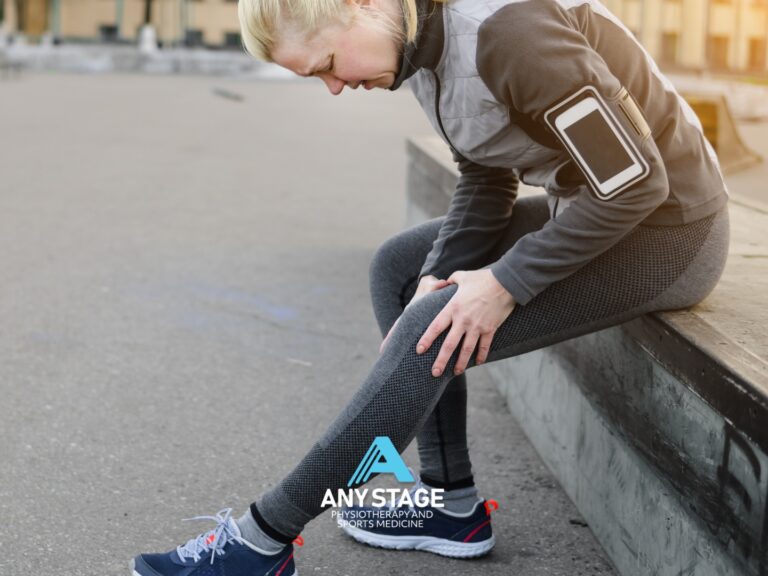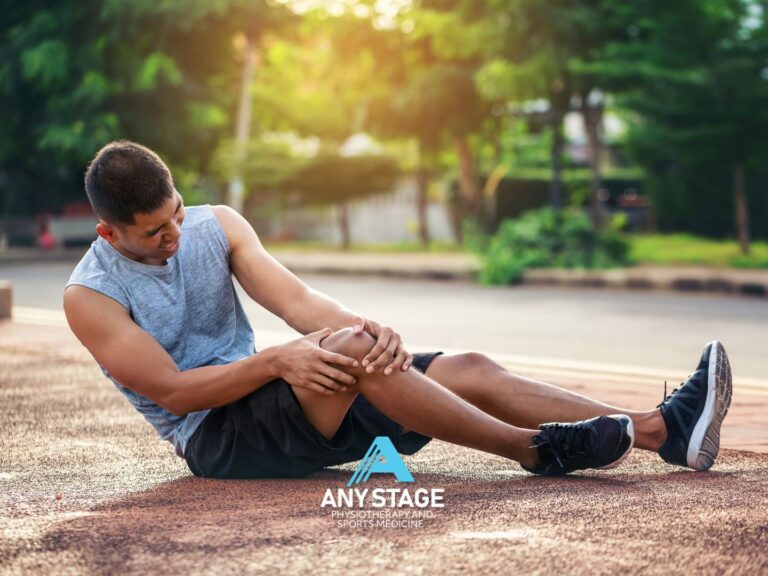In this blog we will cover common injuries and management of the Achilles tendon, including:
- Achilles tendinopathy:
- Mid portion tendinopathy
- Insertional tendinopathy
- Achilles rupture
What is Achilles Tendon?
Anatomy
The Achilles tendon, also known as the calcaneal tendon, is the largest and strongest tendon in the human body. It is located at the back of the lower leg and connects the calf muscles (gastrocnemius and soleus) to the heel bone (calcaneus). The Achilles tendon plays a crucial role in the movement of the foot and ankle, specifically in plantarflexion, which involves pointing the foot downward.
The anatomy of the Achilles tendon consists of several important structures:
Gastrocnemius Muscle
The gastrocnemius muscle is one of the calf muscles and forms the upper part of the Achilles tendon. It originates from the back of the femur (thighbone) and merges with the soleus muscle to form the Achilles tendon.
Soleus Muscle
The soleus muscle is another calf muscle located deeper than the gastrocnemius muscle. It originates from the upper part of the fibula and tibia (lower leg bones) and also contributes to the formation of the Achilles tendon.
Achilles Tendon
The Achilles tendon begins at the junction of the gastrocnemius and soleus muscles, approximately 8-10cm above the heel bone. It continues downward, attaching to the back of the calcaneus (heel bone). The tendon is composed primarily of collagen fibres, which provide strength and flexibility.
The Achilles tendon is responsible for transmitting the force generated by the calf muscles to the heel bone, enabling various activities such as walking, running, jumping, and pushing off during propulsion. It acts like a spring, storing and releasing energy during movements.
Mechanism of mid-portion Achilles injury
Due to its location and function, the Achilles tendon is vulnerable to injuries and conditions such as Achilles tendinopathy or Achilles tendon rupture. These can occur due to overuse, repetitive stress, sudden increases in activity, or traumatic events.
Understanding the anatomy of the Achilles tendon is crucial in diagnosing and treating related conditions. Our physiotherapists at Any Stage Physiotherapy and Sports Medicine can assess the integrity of the tendon, evaluate any abnormalities or injuries, and develop appropriate management strategies to promote healing and restore function.
Achilles Tendinopathy: Mid portion
Mid-portion Achilles tendinopathy, also known as mid-portion Achilles tendonitis or tendinosis, refers to a condition characterised by pain and degeneration in the middle part of the Achilles tendon, typically located a few centimetres above the heel bone.
The exact cause of mid-portion Achilles tendinopathy is not fully understood, but it is believed to result from a combination of factors including:
- Overuse, variable training/playing loads or repetitive strain: Engaging in activities that involve repetitive jumping, running, or excessive stress on the Achilles tendon can lead to microtrauma and degeneration. Inconsistent training loads can have a significant effect on the Achilles tendon.
- Biomechanical factors: Abnormal foot mechanics, such as overpronation or high arches, can alter the distribution of forces along the Achilles tendon, placing increased stress on the mid-portion.
- Training errors: Sudden increases in activity level, inadequate rest and recovery, or inappropriate footwear during training or sports activities can contribute to the development of mid-portion Achilles tendinopathy.
- Age and activity level: The condition is more common in individuals who are active, participate in sports, or are in their mid-30s to mid-50s.
Symptoms of mid-portion Achilles tendinopathy
Over time, mid portion Achilles pain can become more persistent and affect daily activities, even when at rest.
- Pain and stiffness along the Achilles tendon, especially at the back of the heel.
- Pain that worsens with activity, particularly during running, jumping, or climbing stairs.
- Tenderness and swelling around the Achilles tendon.
- Morning stiffness and pain that eases with gentle activity.
Treatment for mid-portion Achilles tendinopathy
Treatment typically involves a combination of conservative measures aimed at reducing pain, promoting healing, and restoring function:
- Relative rest and activity modification
Reducing or avoiding activities that aggravate symptoms to allow the tendon to heal in the initial phase of treatment. Early load through the tendon at a tolerable level is advised.
- Pain management
Soft-tissue modalities for the tendon and calf musculature.
- Eccentric strengthening exercises
These exercises involve controlled lengthening of the Achilles tendon while loading it, which has shown to be beneficial for tendon healing.
- Gradual return to activity
Once symptoms improve, a gradual return to activity and sports is recommended to prevent re-injury.
There are three phases to rehabilitation of the mid portion Achilles tendinopathy:
Phase 1: isometric loading – calf raise holds
Isometric tendon loading not only has pain-relieving effects on tendons, but also simultaneously maintains some baseline strength. Depending on symptoms and tendon pain behaviours, these can be performed in either double leg or a single leg position.
These typically include holding a calf raise in the mid-range for 20-45 seconds in both standing and seated positions.
Phase 2: isotonic loading
This phase includes seated and standing repetitive calf raises with a focus on the eccentric (lowering) phase, building up in resistance/weights and range from flat ground to off a step.
Phase 3: Energy storage loading – Plyometric exercises
The crucial last stage of rehabilitation is the initiation and execution of ‘energy storage’ tendon exercises. These exercises help the tendon to regain its capacity to absorb and then release energy via the stretch-shortening cycle, that happens when an athlete lands and then pushes off at through the ball of the foot.
The criteria for initiating these plyometric exercises include:
- Minimal or markedly reduced morning stiffness in Achilles tendon
- Following successful progressions through isotonic calf raise exercises
- Very mild tenderness on palpation of the Achilles tendon
- Able to tolerate light running without increase in symptoms or a flare-up.
Plyometric exercises include but are not limited to the following:
- Double-leg hop
- Single leg hop
- Single leg step hops
- Counter movement jumps
- Depth jumps
- Bounding
Insertional (entheses) Tendinopathy
Insertional Achilles tendinopathy refers to a condition characterised by pain and degeneration at the insertion point of the Achilles tendon on the heel bone (calcaneus). Unlike mid-portion Achilles tendinopathy that affects the middle portion of the tendon, insertional Achilles tendinopathy occurs where the tendon attaches to the calcaneus.
Mechanism of insertional Achilles tendinopathy injury
Some potential causes of insertional Achilles tendinopathy can be similar to mid portion, including overuse and/or repetitive stress, and biomechanical factors. However, there are also additional factors that can predispose someone to experience insertional Achilles tendinopathy including:
- Bone spurs or calcification: Over time, the repetitive stress on the tendon can cause the body to deposit calcium and form bone spurs at the insertion point, which can irritate and damage the tendon.
- Haglund’s deformity: This is a bony prominence on the back of the calcaneus, commonly referred to as a “pump bump.” It can contribute to insertional Achilles tendinopathy by irritating and compressing the tendon against the shoe.
- Trauma or direct injury: In some cases, a direct blow to the heel or a sudden forceful contraction of the calf muscles can cause damage to the Achilles tendon at its insertion.
The hallmark symptom of insertional Achilles tendinopathy is pain at the back of the heel, specifically at the insertion point of the tendon. The pain may be worsened by activities such as walking, running, and jumping. Other symptoms may include tenderness, swelling, and stiffness in the area. In some cases, there may be the formation of a visible bump or prominence at the back of the heel.
Treatment of insertional Achilles tendinopathy
Treatment for insertional Achilles tendinopathy does differ from midportion in that we need to reduce the pull and stretch of the tendon to limit the microtrauma at the tendon/bone junction. Therefore, we need to limit the amount of range the ankle goes into. This is typically done with heel lifts or padding in the shoe to help relieve pressure on the tendon and reduce discomfort. Stretching the calves is not recommended in insertional Achilles tendinopathy to reduce irritation at the insertion site. The strengthening exercises for insertional tendinopathy are similar to the mid portion exercises outlined above. However, the marked difference includes limiting the range of motion the ankle moves through when performing calf raises, therefore not performing them off a step, but rather the flat floor.
Achilles Rupture
An achilles rupture refers to a partial or complete tear of the achilles tendon. It is often a result of a sudden, forceful contraction of the calf muscles or a direct trauma to the back of the leg.
Achilles ruptures commonly occur in individuals involved in sports that require explosive movements, such as basketball, soccer, or tennis. They are more prevalent in males over the age of 30 and are often associated with underlying tendinopathy or degeneration of the tendon.
The symptoms of an Achilles rupture may include:
- Sudden, sharp pain in the back of the leg or ankle, often described as a “pop” or “snap” sensation. Some report feeling of being “kicked” in the leg
- Difficulty or inability to walk or weight bear on the affected leg.
- Swelling and bruising around the heel and lower leg.
- A noticeable gap or indentation in the achilles tendon.
- Weakness or loss of power when attempting to push off the foot.
Treatment options for an Achilles rupture may include:
- Non-surgical treatment
This approach is typically reserved for individuals with a partial tear or those who are not good candidates for surgery (may have underlying health conditions etc.). It involves wearing a cast or boot with heel inserts and undergoing a rehabilitation program that includes exercises to regain strength and ankle mobility. Removing the heel inserts is performed gradually over time, increasing the ankle range of motion.
- Surgical repair
For most individuals, especially those with a complete rupture and active lifestyles, surgical intervention is recommended. The procedure usually involves making an incision to access the torn ends of the Achilles tendon and stitching them back together. In some cases, a graft may be used to reinforce the repair. Following surgery, a period of immobilisation and rehabilitation is required to restore function. Physiotherapy guided treatment allows for specific progressions through the rehabilitation process.
The recovery timeline for an Achilles rupture
Recovery varies depending on several factors, including the severity of the rupture, the chosen treatment approach, and individual healing capabilities. Non-surgical treatment may involve several weeks of immobilisation followed by a gradual return to weight-bearing and physiotherapy. Surgical repair typically requires a longer recovery period, with immobilisation in a cast or boot for several weeks and a more extensive rehabilitation program.
Final thoughts on Achilles Tendon Injury
Our experienced staff at Any Stage Physiotherapy and Sports Medicine is able to guide you through the recovery process. We ensure that you achieve proper healing, regain strength and mobility, and prevent re-injury. Rehabilitation typically includes exercises to improve range of motion, strength, and balance, as well as gradual return to weight-bearing activities and sports-specific training.
Assistance
If you are currently experiencing symptoms of Achilles tendinopathy or heel pain, please do not hesitate to contact our friendly and experienced staff at Any Stage Physiotherapy and Sports Medicine. We will provide an accurate diagnosis and appropriate management strategies, specific to your lifestyle and goals.
Authors


Daniel Lee
DPT, B. Sc, APAM
Director / Principal Physiotherapist
Daniel Lee has created a specialised approach to Physiotherapy treatment, return to sport and injury prevention by incorporating a functional strength & conditioning approach, no matter the individual’s age, sport, lifestyle, or competition level.

Shannon Murray
DPT, B. HSc, APAM
Physiotherapist
Shannon completed her Doctor of Physiotherapy degree at Macquarie University, after relocating from Queensland, where she completed her Bachelor of Health Science degree. Whilst completing her Doctor of Physiotherapy degree, she gained valuable experience in various setting, including private practice and hospital.










